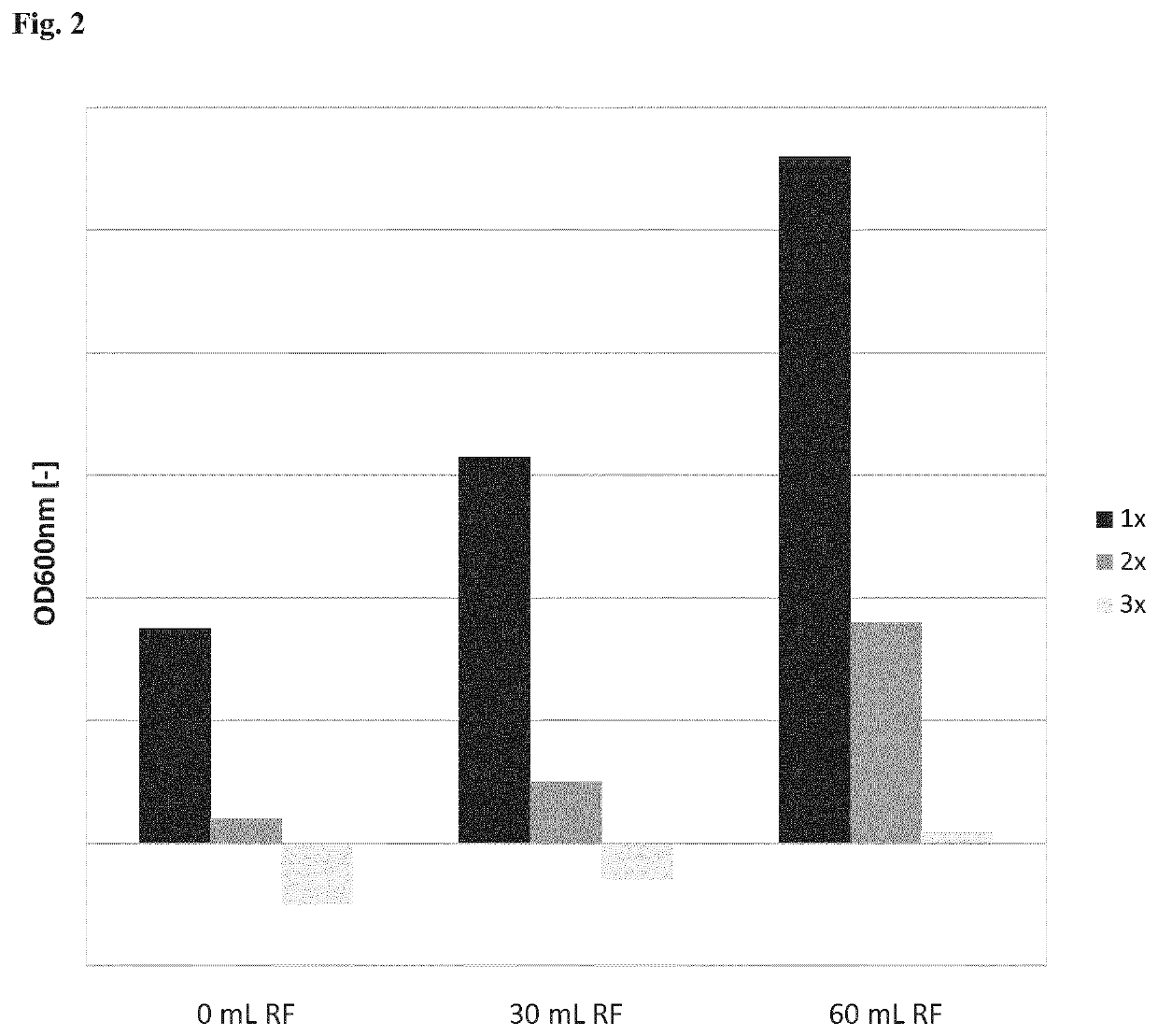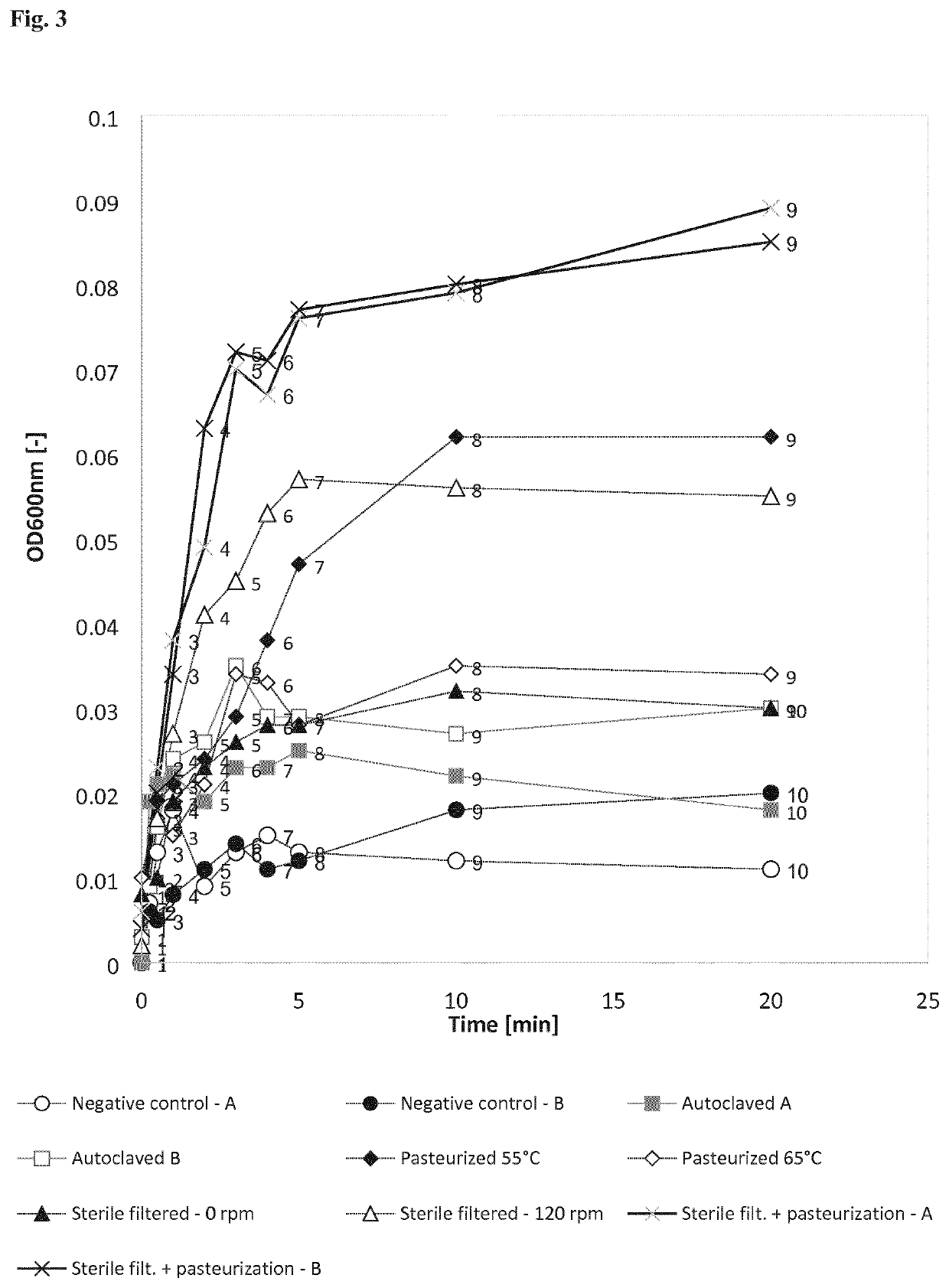Method of preparing prebiotic dietary fiber and probiotic-fibre complexes
a technology of probiotic fibre and dietary fiber, which is applied in the field of prebiotic dietary fibre and probiotic integration/encapsulation, can solve the problems of imbalanced rumen microbial population, difficult encapsulation of probiotics in the animal feed industry, and vulnerable weaning calves and piglets to infections, etc., to achieve the effect of improving nutrient absorption and immune fitness
- Summary
- Abstract
- Description
- Claims
- Application Information
AI Technical Summary
Benefits of technology
Problems solved by technology
Method used
Image
Examples
example 1
[0156]Preparation of Sterile Bioactive Prebiotic Fibrous Material:
[0157]Step 1. Filtration of Rumen Fluid to Obtain Clarified Rumen Fluid
[0158]Collect 110 Kg raw rumen content. Warm to 50° C. and mix vigorously to dissociate proteins into the liquid fraction. Place rumen contents (solid and liquid materials) in nylon fabric filter with 1 ml holes, centrifuge 300 rpm for 10 minutes to obtain 35 L of rumen fluid (RF).
[0159]Next, continue to perform sequential filtering with progressively finer filtration cassettes as follows:
[0160]3.0 micron filter
[0161]0.9 micron filter
[0162]0.25 micron filter
[0163]0.22 micron filter
[0164]The sequential filtration process (starting with 110 Kg raw content) will yield in the order of 10 L of clarified rumen fluid.
[0165]The clarified rumen fluid may be stored by refrigeration or freezing.
[0166]Step 2. Pasteurization of Clarified Rumen Fluid
[0167]Pasteurization (50° C.-70° C.) further ensures the inactivation of microorganisms including viruses and dena...
example 2
[0177]Preparation of Probiotic-Fiber-Complex Composition Capable of Affording Thermal or Mechanical Stresses Resulting from Industrial Feed or Food Processing
[0178]The sterile bioactive prebiotic fiber material prepared as in example-1 is added at a ratio of 1:10 to M. smithii standard growth media containing 1012 M. smithii cells per mL media and incubated anaerobically gassed with 4 parts H2 and 1 part CO2, under 2 bars pressure for 6 hours as is routine for M. smithii culture. The fiber material is afterwards isolated / separated from the culture media using a nylon mesh strainer (40 micron). Scanning electron microcoscopy reveals the fiber material is densely colonized with / adhered to by M. smithii cells. The product is defined as probiotic-fiber-complex. The probiotic-fiber-complex composition may be preserved using such standard cryopreservation methods as freeze-drying.
[0179]Scanning electron microscopy reveals that standard fibers (not integrated with pasteurized clarified rum...
example 3
[0183]Processing of Rumen Content and Porphyra Seaweed to Form a Cellulosic Fiber Feed Material as Probiotic Carrier:
[0184]Rumen content (RC) containing partially digested forage was harvested from healthy organic cows (Uelihoff abattoir Ebikon, Switzerland) following slaughter. RC was heated to 50° C. and mixed vigorously for 15 minutes and / or sonicated to dissociate proteins from the solid fraction into the liquid fraction. Heating and agitating the rumen content increases the protein concentration in the rumen fluid fraction. The treated RC was then pressed using a grape-press to collect the rumen fluid fraction while the solid fraction was discarded. The warm rumen fluid fraction was filtered with progressively finer filtration cassettes as follows:
[0185]3.0 micron filter
[0186]0.9 micron filter
[0187]0.25 micron filter
[0188]0.22 micron filter
[0189]The rumen fluid passes more readily through the filters (less filter fowling) when it is heated. The clarified rumen fluid was further...
PUM
 Login to View More
Login to View More Abstract
Description
Claims
Application Information
 Login to View More
Login to View More - R&D
- Intellectual Property
- Life Sciences
- Materials
- Tech Scout
- Unparalleled Data Quality
- Higher Quality Content
- 60% Fewer Hallucinations
Browse by: Latest US Patents, China's latest patents, Technical Efficacy Thesaurus, Application Domain, Technology Topic, Popular Technical Reports.
© 2025 PatSnap. All rights reserved.Legal|Privacy policy|Modern Slavery Act Transparency Statement|Sitemap|About US| Contact US: help@patsnap.com



